BandLab
INTRODUCTION
Many musicians seek to team up with others to collaborate on projects or form bands, however there is a shortage of tailored solutions for connecting musicians. The result is that artists often struggle to find like-minded partners with complementary skills and styles, making it difficult to collaborate effectively.
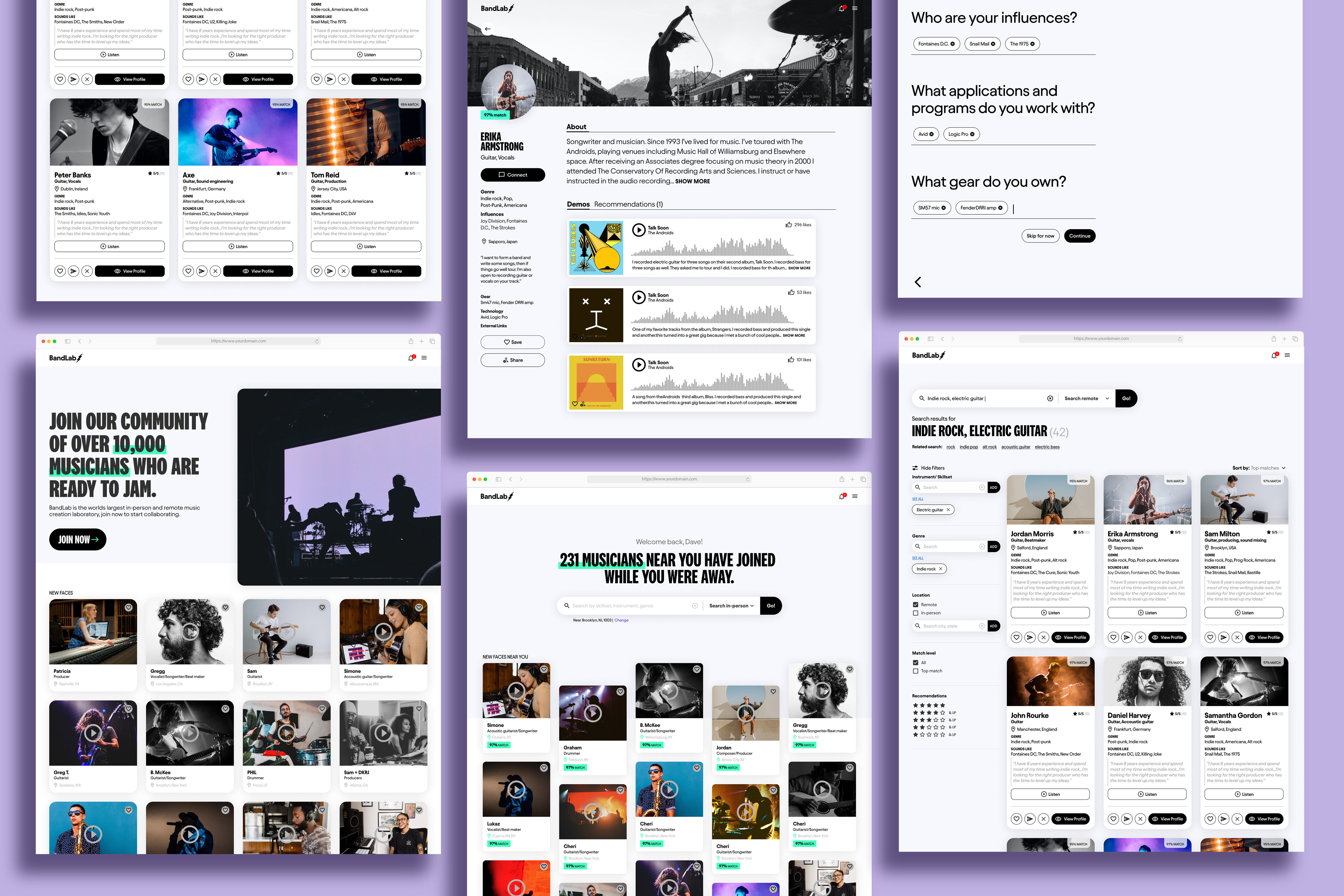
At the same time, the pandemic has uncovered the potential for remote collaboration:
It expands networks beyond a geographic location, increasing exposure to diverse perspectives.
It exposes artists to a collaborators fan base, and vice versa. Larger audiences = greater chance of getting discovered.
It opens doors to further opportunities: more gigs and possible industry contacts.
TIMEFRAME
ROLE
THE CHALLENGE
Jan 2022 - Apr 2022
ROLE
Product designer : UX strategy, discovery research, wireframes, prototyping, usability tests, design system development, project management.
THE CHALLENGE
How might we design a system that helps music creators to connect and collaborate, fostering a thriving community of artists working together on music projects?
“The more experienced I get the more focused my music ideas are, which makes it harder to find people to collaborate with. Finding artists that fit a similar vision is tough.”
INTERVIEW PARTICIPANT

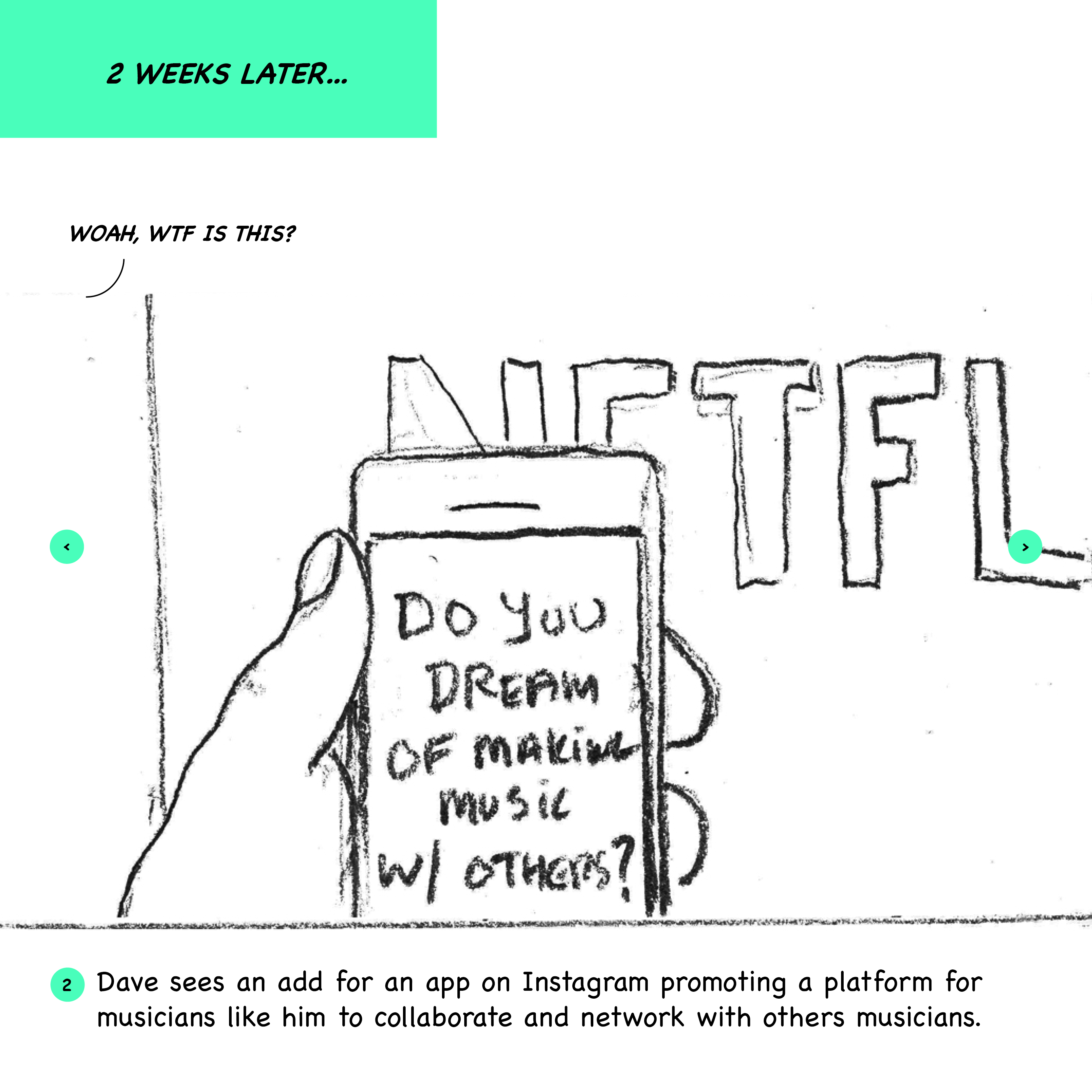
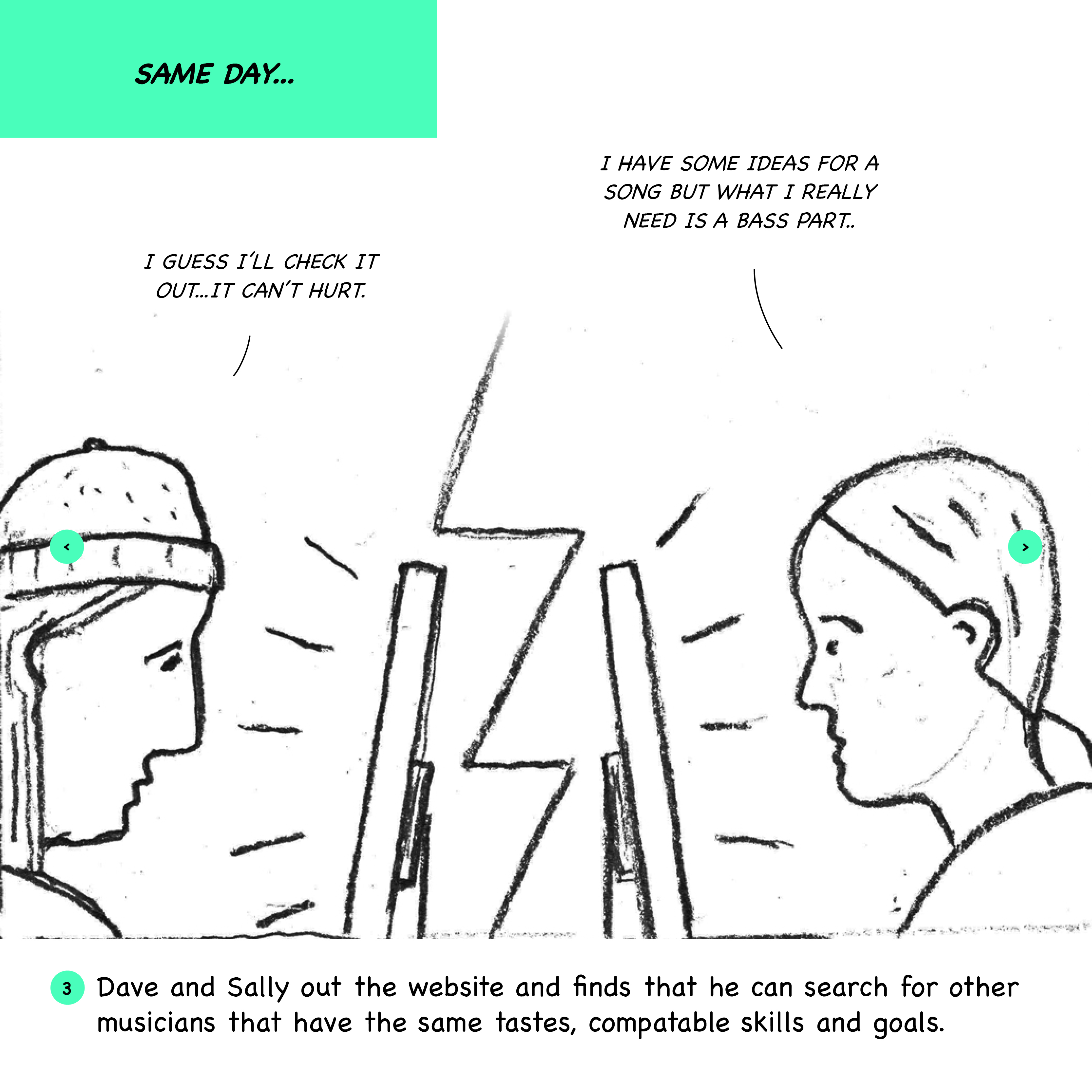

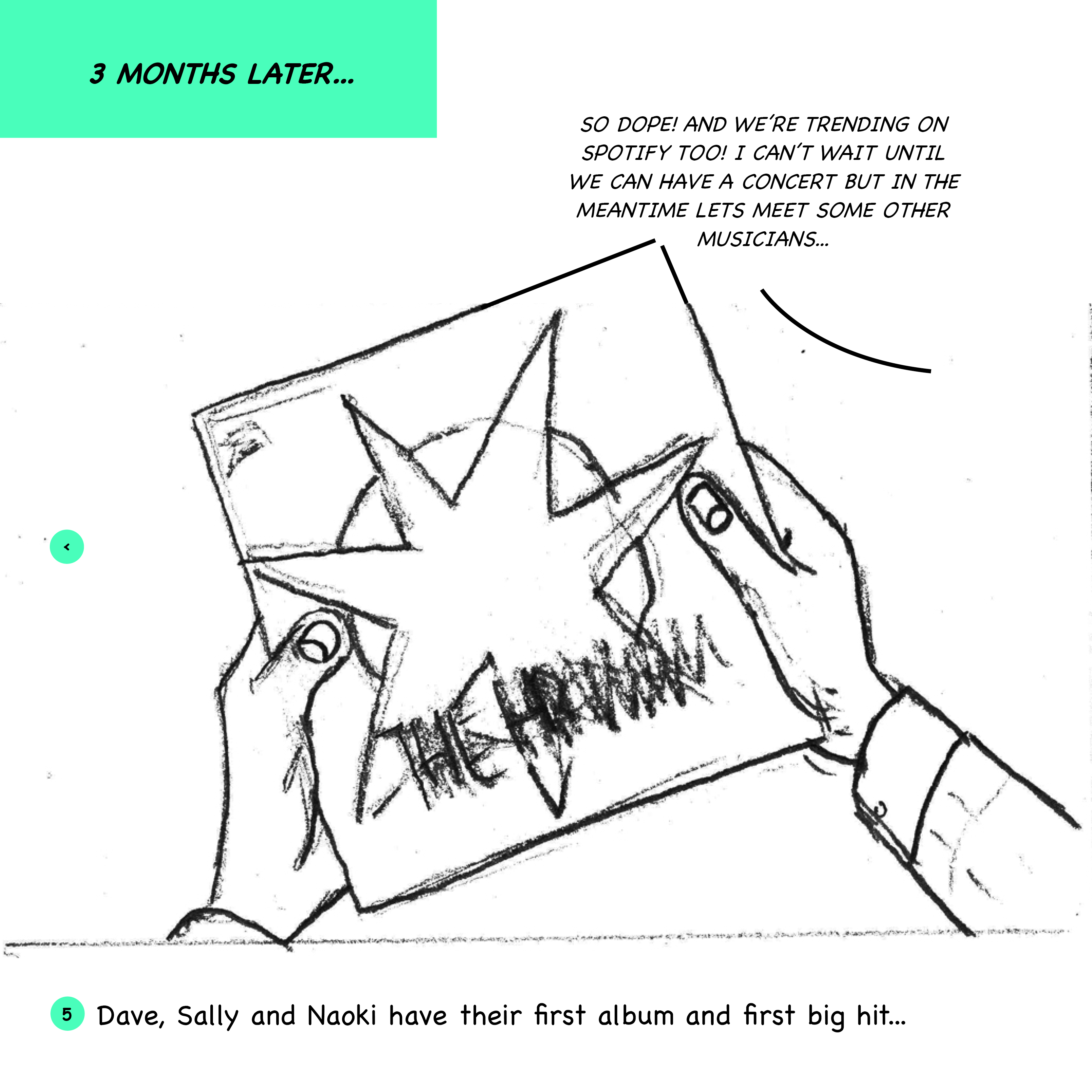
ABOVE: An early storyboard helped communicate the concept to stakeholders.
RESEARCH: EARLY INSIGHTS
![]()
A competitive analysis was performed to gain a better understanding of the problem area and existing solutions. While a number of solutions already exist on the market which musicians use to develop networks and identify potential collaborators, many of these are informal or are targeted towards professional musicians, so there is room in the marketplace for an easy-to-use solution targeted towards amateur and aspiring musicians.

ABOVE: A competitive analysis matrix created to better understand competition.
View the full competitive analysis here.
Findings:RESEARCH: DIGGING DEEPER
Musicians use informal solutions such as sub-groups in Reddit to find collaborators, however these platforms do not offer specific tools to help musicians search for and evaluate potential collaborators.
Many existing solutions (Soundtrap and Vocalizr) offer good user experiences but are targeted towards professionals and are based on monetary exchange.
Many existing solutions require the purchase of proprietary recording technology (Landr, Avid and Soundtrap).
To better understand my target audience’s goals and challenges, 1:1 interviews and a survey with aspiring and professional musicians were conducted.
Research questions:
What are the characteristics of a successful musical collaboration?
What are the characteristics of a unsuccessful musical collaboration?
Why do musicans seek out collaborators?
How do they currently find collaborators?
Research methods:
Five, 1 hour, 1:1 user interviews with professional and aspiring musicians.
A survey of 33 professional and aspiring musicians.
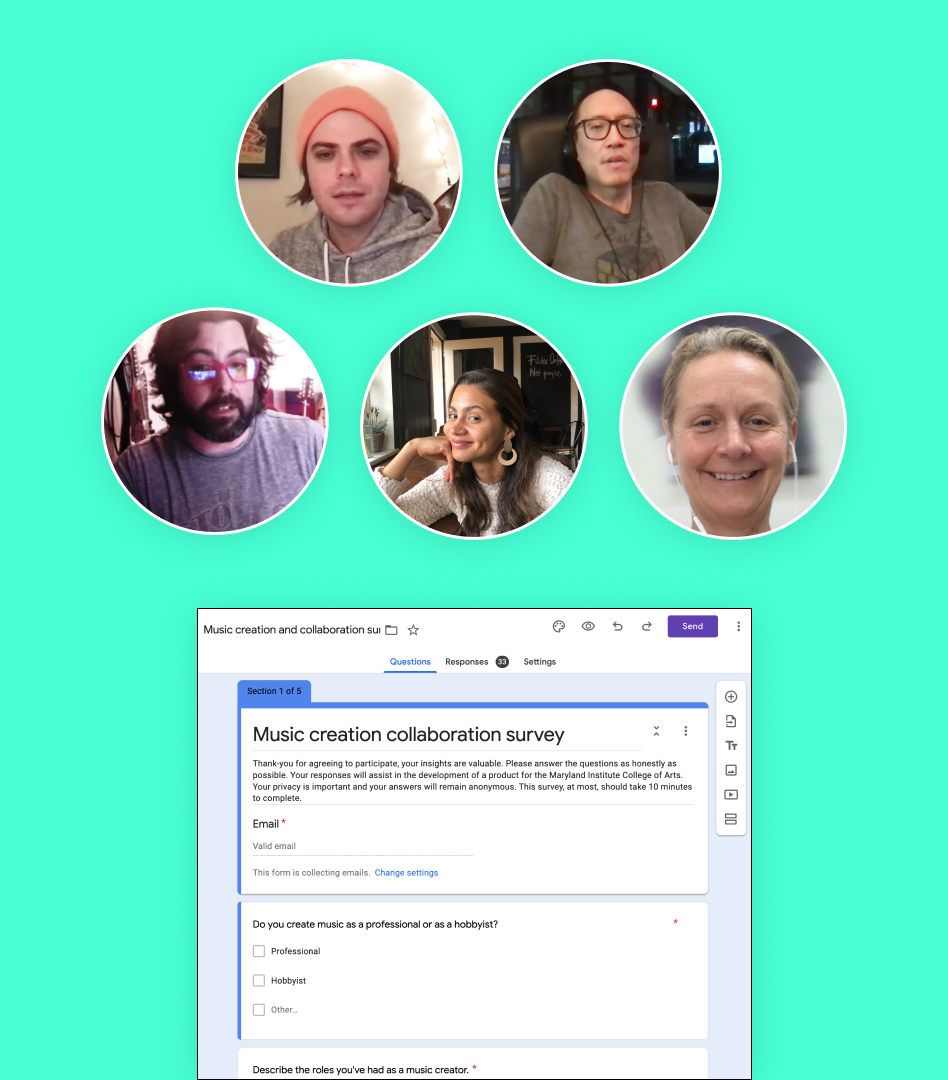

ABOVE: Synthesizing the data into an affinity map, organizing data points into thematic groups.
Findings:
42%of responents said they have collaborated with other musicians in the past year.
48%of those said they collaborated remotely.
51%said they look for opportunities to collaborate with others.
The research also identified 5 common attributes found in successful music collaboration:
Similar taste & vision: Is there a similarity of tastes and do collaborators like the same genres of music?
Complementary skill sets: Are the skillsets complementary and what is the collaborators skill level?
Alignment of goals: Do their commzitment, ambition and dedication match? Do each other's goals align?
Technology, applications & programs: Are they able to record at a high quality and on compatible platforms
Compatible personalities: Is the other person open to feedback, and easy to work with? Do they have an ego? Are they organized, and responsive?
“Working with people that have similar tastes is important...each person needs to be able to put themselves in the others shoes and understand how to think from the others perspective.”
INTERVIEW PARTICIPANT
RESEARCH: PERSONAS & USER JOURNEYS
Personas and user journey maps were then developed, consolidating the goals, behaviors, needs and pain points of the target users.



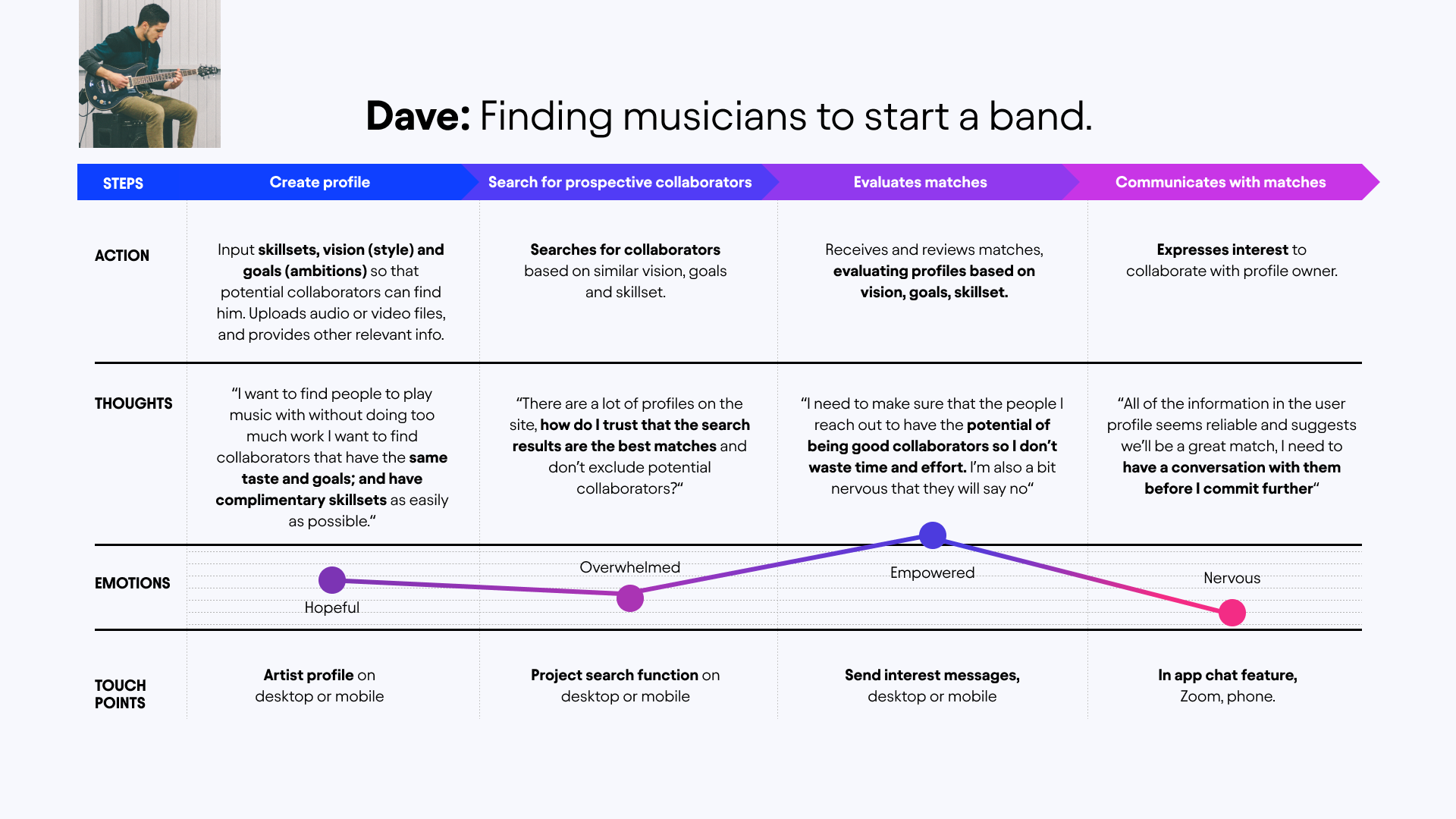

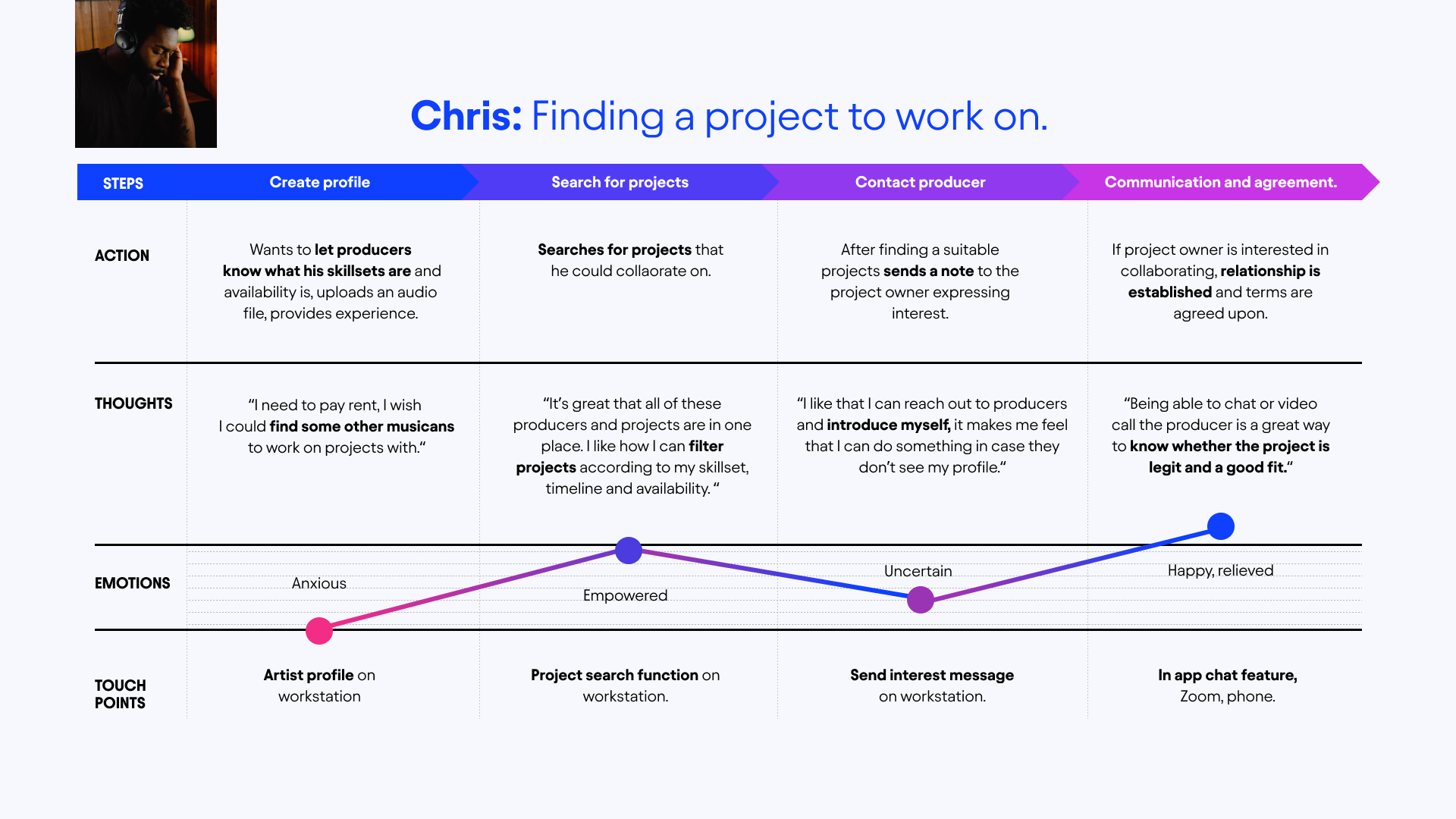
ABOVE: Personas & journey maps.
RESEARCH: TASK FLOWS
A sprint map and task flows were developed to understand the steps a user would take to create a profile page and search for collaborators.
This process began to uncover the key steps in the user journey and an area of opportunity: once a set of results has been produced from a search, how would users evaluate profiles, and how could the platform help make the evaluation process easier and more efficient for them? Could the system help match compatible users based on the key attributes uncovered in the research?
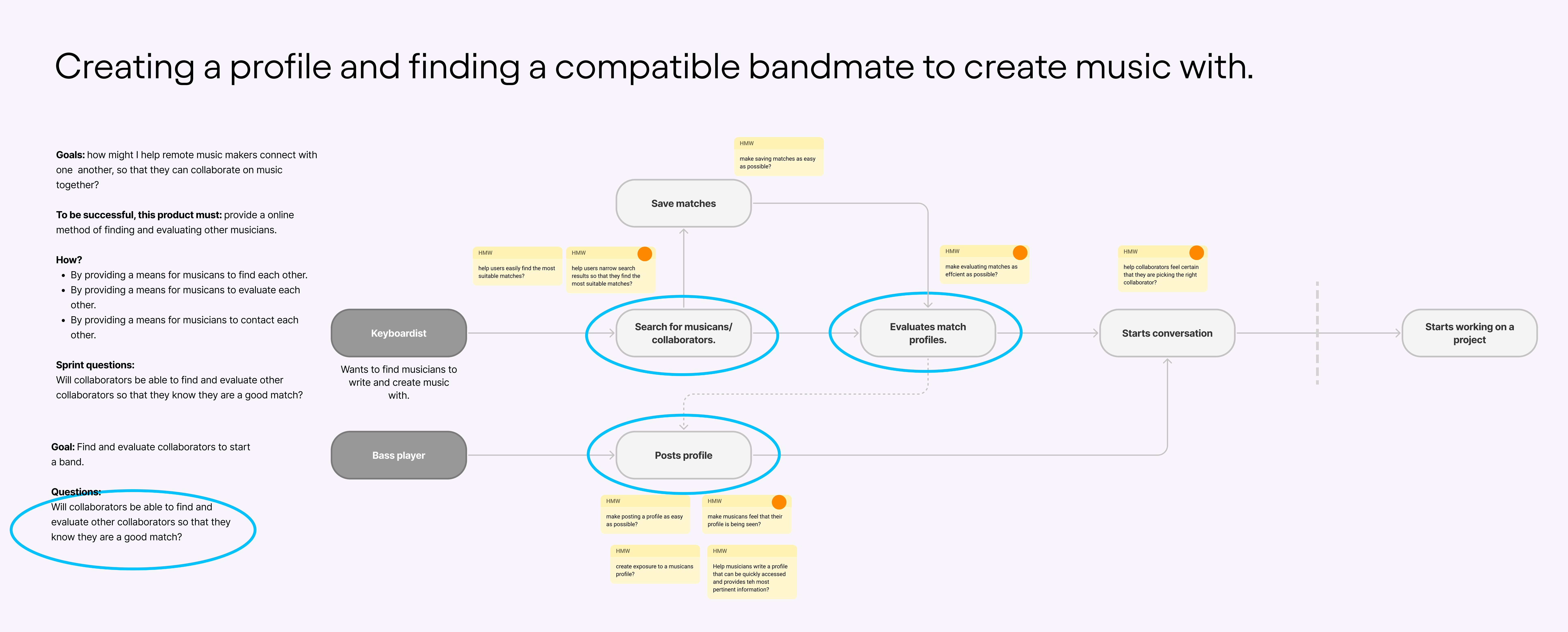

ABOVE: Task flows.
THE SOLUTION: FEATURES
In addition to the search results page, the research indicated 4 main features that would be useful for users in their journey:
Onboarding questionnaire: used to identify a user's personality, goals, taste/vision, skill sets, and technological capabilities.
Profile page: a public facing page created from the questionnaire.
Search page: used to search for profiles by genre, goals and skill sets.
Search results page: used by users to evaluate profiles.
THE SOLUTION: USER FLOW
A detailed user flow helped flesh out the steps for each feature and connect flows together. The solution would require a robust onboarding questionnaire which would identify a users tastes, goals and skillsets. The platform could then use these attributes to create a profile and match compatible users via a search.

ABOVE: A detailed user flow showing how users would journey through the application.
THE SOLUTION: IDEATION & SKETCHING
Sketching and solution sketching helped generate ideas and flesh out interaction details for the 4 main flows.

ABOVE: Working rough concepts into solution sketches, and then into mid-fidelity wireframes.
THE SOLUTION: STORYBOARDS
Storyboards were crafted to gain a better understanding of how target users may use the product and what feature set they would need to fulfill the goal of finding other musicians to collaborate with. A range of scenarios were developed, from a broad use case to more granular task-based stories.

THE SOLUTION: WIREFLOWS
Wireflows were used to develop a happy path and further understand the interactions needed for a user to complete the questionaire, edit a profile, search for and evaluate other musicans.

ABOVE: A detailed wire flow outlining needed interactions for the happy path.
THE SOLUTION: USABILITY TESTS

ABOVE: High-fidelity wireframes used for usability tests.
2 rounds of user tests were conducted, starting with a remote moderated test with 2 participants on mid-fidelity wireframes. This indicated that the key features and workflow were understood, however it was discovered that some interactions and navigation components needed improvement and clarification.
With these changes a high-fidelity prototype was developed which went through further remote and moderated testing. Participants were recruited from a screener posted on a songwriters reddit subgroup as well as through personal contacts. In total, 5 remote moderated user tests, 5 remote user tests, and 3 expert sessions provided feedback for the final high-fidelity prototype. Users were able to complete each flow, however feedback indicated some less severe problems.
Usability test finding #1
Search results card was difficult to scan; some high level content and useful functionality was missing; and match rankings were unclear.
Solution:Change match ranking system to a more accurate percentage rating.
Add an audio sample and user location.
Improve visual hierarchy and group like content.
Consolidate actions together.

Usability test finding #2
Search bar field in the filter tab on the results page is difficult to use as it cut off their entry.
Solution:Design should allow for longer text entries.

Usability test finding #3Language is ambigious, unclear, or too formal at times.
Language is ambigious, unclear, or too formal at times.
Solution:Change ‘Reviews’ to ‘Recommendations’ or ‘Endorsements’.
Replace formal language like ‘collaborators’ to more casual and conversational language.
Change ambigious language like ‘technologies’ to be more descriptive and conversational.
Consider implementing a help system.
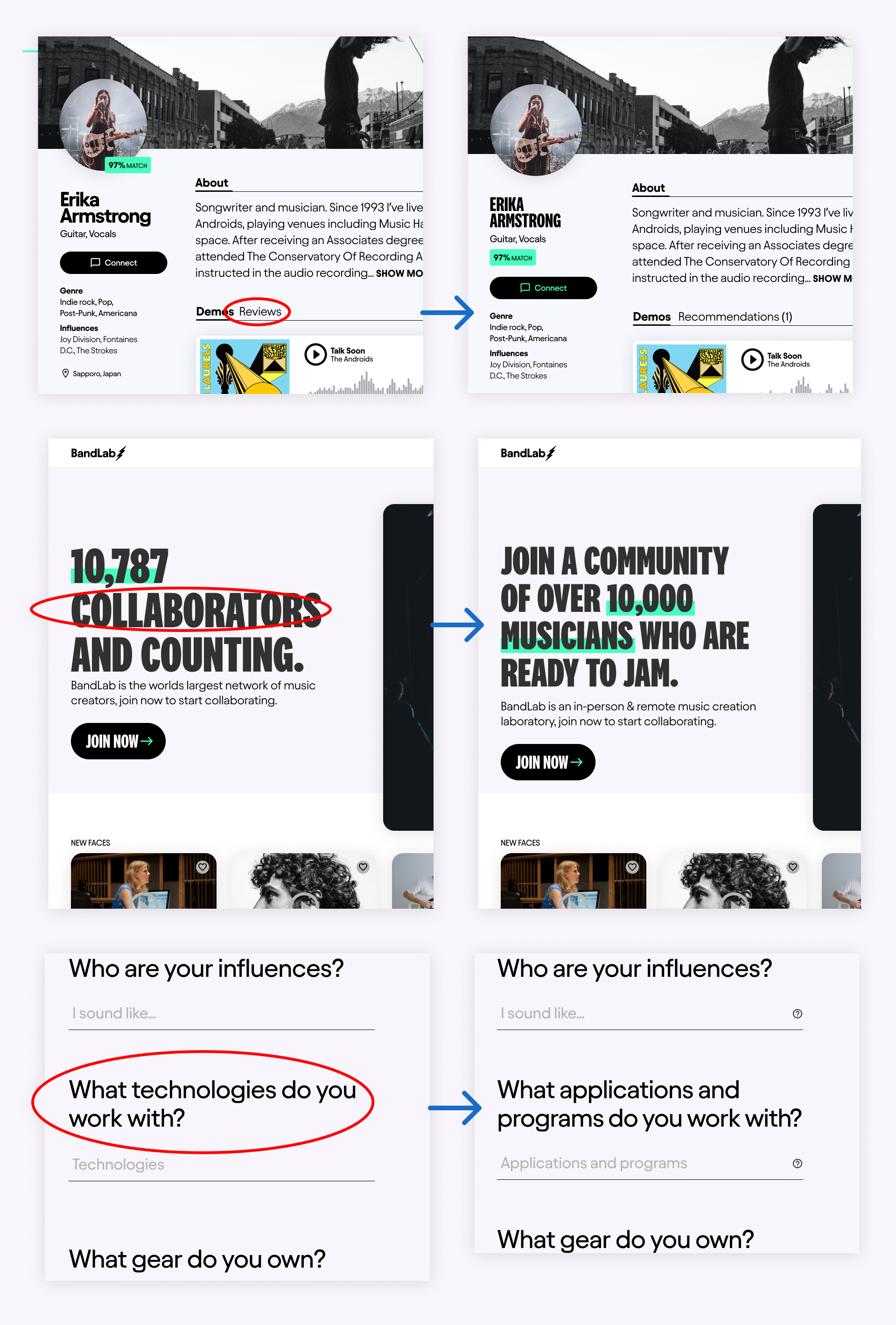




ABOVE: High fidelity screens.
DESIGN SYSTEM


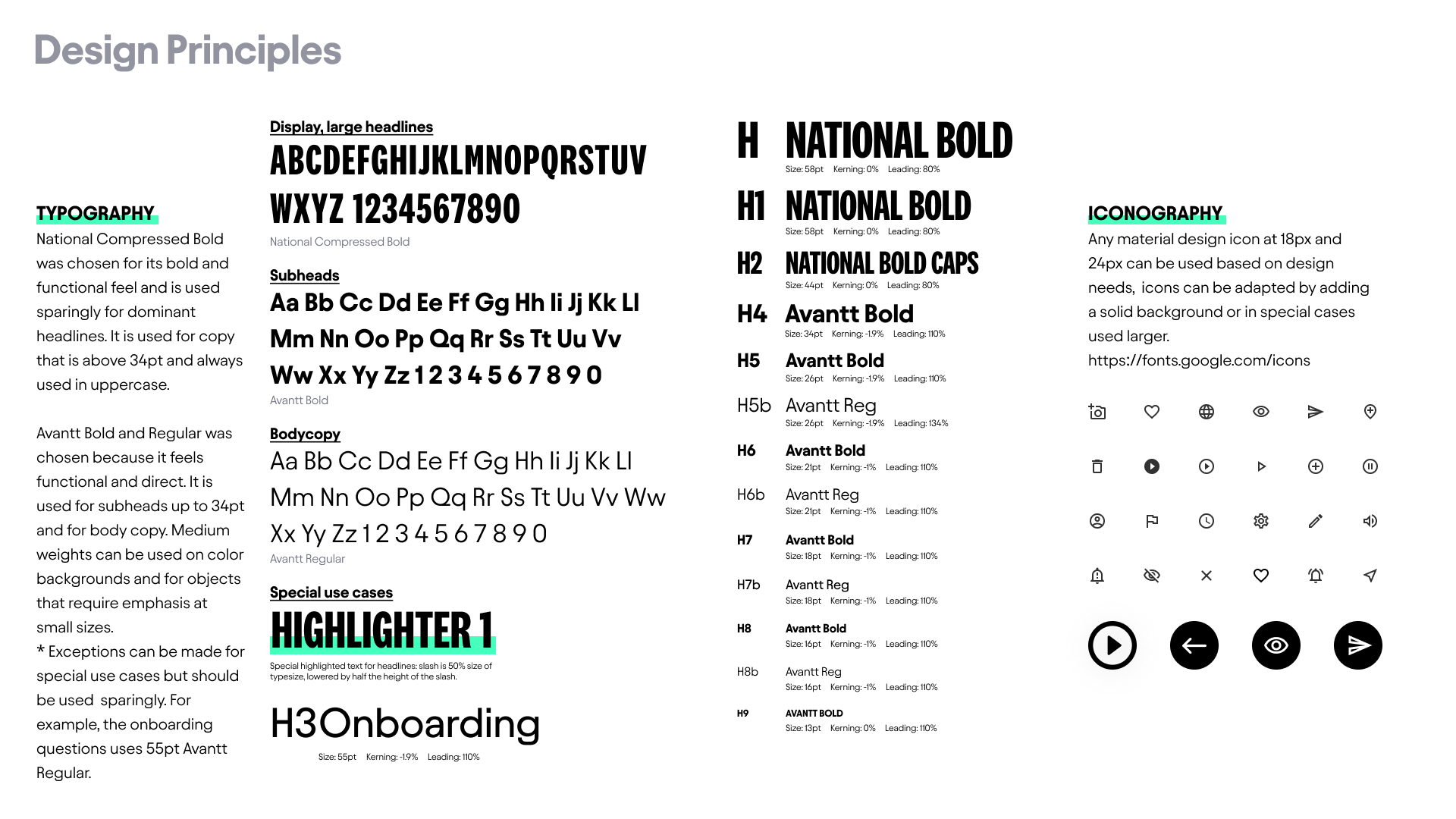



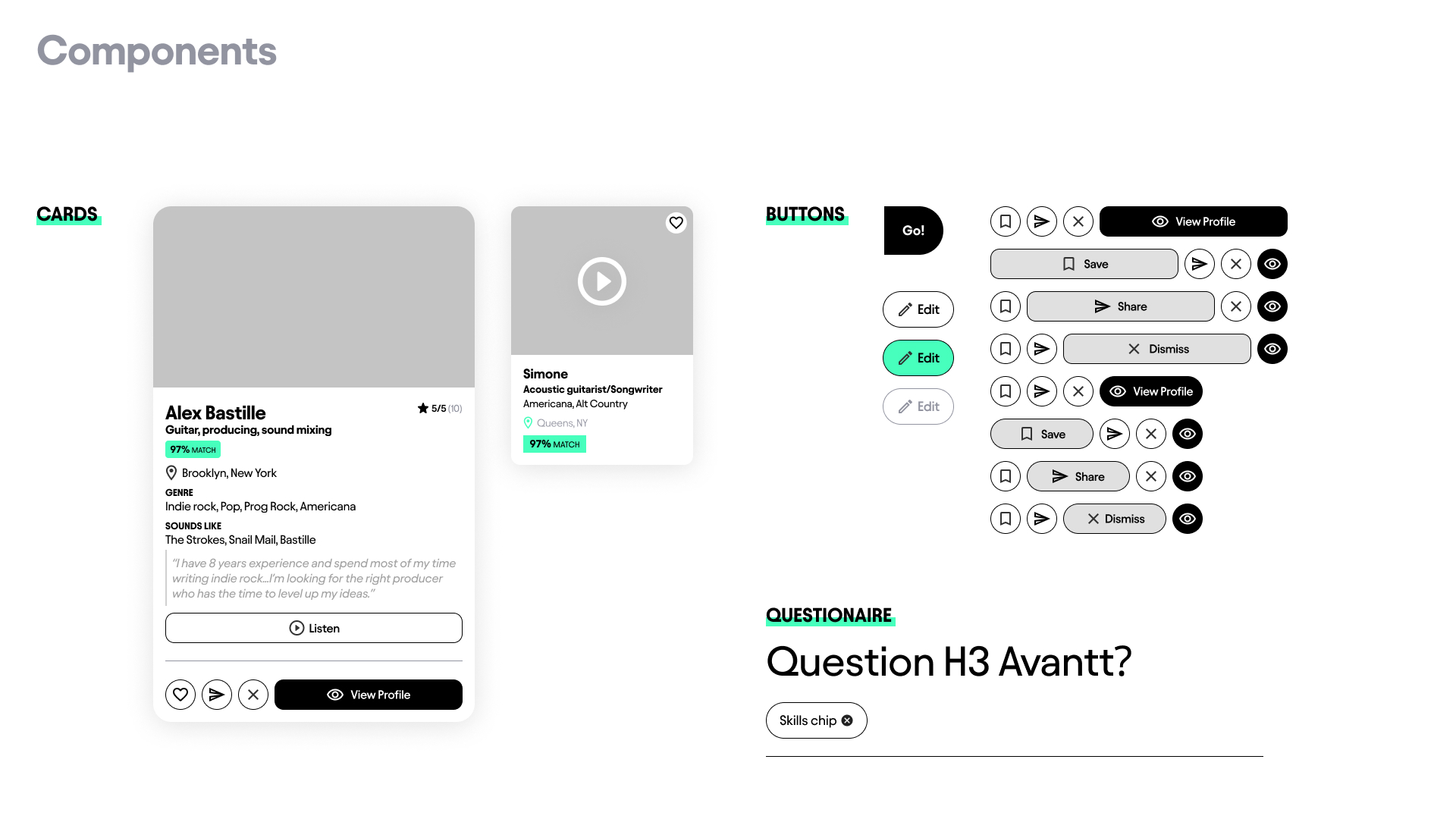

This project was developed as part of the Masters in UX Design program at the Maryland Institute College of Art. Special thanks to my classmates and MICA UX MPS faculty advisors (Christine Chiang, Arkadiy Avrorov, Logan Perez) for providing valuable feedback and expertise.

